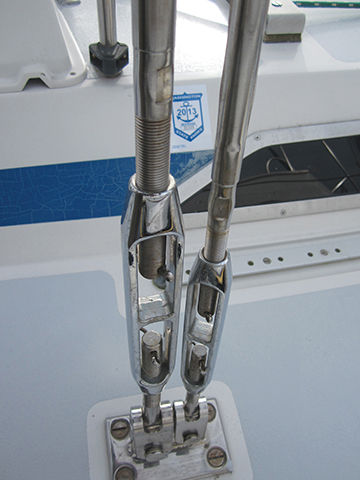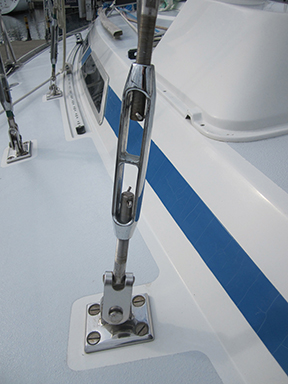What to look for in your rig before heading offshore (published April 2013)
Everything has its place, purpose and importance on an offshore quality sailboat. But when completing a blue water passage, nothing could be more essential to your safety and success than your standing and running rigging. With a reliable rig, you can sail the world’s oceans as you please, but without one, you are an accident waiting to happen.
The problem is, your rig can be easily overlooked or neglected, and for a lot of sailors it can become a set-it-and-forget-it piece of equipment. A competent sailor needs to have a trained eye when looking after a sailboat’s rig. You aren’t just looking at lines, wires and spars. You’re looking at fittings, pins, toggles and fasteners at any number of connection points that can corrode, stretch, bend and break.
As a general rule, it is a good idea to do a thorough deck level inspection of your running and standing rigging a few times a year, a full rig inspection every year and a mast-down inspection every five years. Before embarking on an offshore passage it is good practice to go aloft for an examination of everything at the masthead and all fittings on the mast as you make your descent. Then, during your passage, try to complete a general deck inspection of running and standing rigging at least once a day if conditions allow.
Here is a checklist of things to review when performing a rig inspection before heading offshore. As with any checklist, take a camera and notepad with you to make notes that can be used later.
STANDING RIGGING
 Starting at deck level, take a good look at all your chainplates. Saltwater can invade chainplates like an unstoppable force so inspect them carefully for corrosion and cracking. If you can access the chainplates from inside the vessel, inspect their backing plates, fasteners and the wood or fiberglass around them for corrosion and cracking. Also, don’t forget to take a look at any tie rods inside the vessel as they can corrode, crack and fail overtime as well.
Starting at deck level, take a good look at all your chainplates. Saltwater can invade chainplates like an unstoppable force so inspect them carefully for corrosion and cracking. If you can access the chainplates from inside the vessel, inspect their backing plates, fasteners and the wood or fiberglass around them for corrosion and cracking. Also, don’t forget to take a look at any tie rods inside the vessel as they can corrode, crack and fail overtime as well.
Turnbuckles and their attached fittings are an important component to your standing rigging. Inspect all turnbuckles and toggles for cracks, twists and galling. Make sure all your clevis and cotter pins are of appropriate size and verify that you have spares for each size. Examine the threads on all studs and lubricate them with Tef Gel or Lanocote. If you have closed-bodied turnbuckles make sure the lock nuts are in place and are not frozen.
Inspect your furling system on a calm day by having a crewmember roll the sail in and out while you look at how the unit is running at the bow. Check the unit’s hardware inside and out to make sure everything is tight and corrosion free. Some furlers have a nut underneath the drum that when loose, causes the furler to spin the turnbuckle, which will change the tune of your rig, or worse, cause it to fail.
 Now take a look at all the wire that makes up your stays and shrouds. Look for any kinks or broken strands, corrosion or signs of obvious fatigue. Pay attention to the various swage fittings connecting to turnbuckles or at the mast. When water runs down the wire it collects in the top of the swage causing corrosion. Again, look for cracks, corrosion, elongation or bends. T-ball fittings and pins can develop tiny cracks that will eventually lead to failure, so look closely.
Now take a look at all the wire that makes up your stays and shrouds. Look for any kinks or broken strands, corrosion or signs of obvious fatigue. Pay attention to the various swage fittings connecting to turnbuckles or at the mast. When water runs down the wire it collects in the top of the swage causing corrosion. Again, look for cracks, corrosion, elongation or bends. T-ball fittings and pins can develop tiny cracks that will eventually lead to failure, so look closely.
Your spars are just as important as what is holding them up, so be prepared to go aloft when completing this part of the checklist. Start by checking anything that is fastened to your mast or boom. The gooseneck is a source of trouble on many boats so give it a good look and replace any rivets or bolts that are suspect. Don’t forget about tracks and cars for spinnaker or whisker poles, cleats, winches, bales and blocks. If you have a deck-stepped mast, check the mast step for corrosion or wear and inspect any blocks that are attached to it. If your mast is keel-stepped, check the mast boot and look at the mast’s connection point in the bilge. Water shouldn’t be pooling up near the base of the mast so ensure bilge water can move freely from that area.
When going aloft, start at the masthead and work your way down. Check all instruments, antennas and lights visually by having someone on deck turn them on and off. Look at all the tangs and connections for shrouds and stays. Pay special attention to sheave boxes for every halyard, and if your mast is fitted with a halyard restrainer for your headsail, now is the time to make sure it is properly run. Don’t forget to thoroughly inspect spreader bases and ends. Spreaders get a fair amount of load put on them and if they fail, your mast is coming down.
RUNNING RIGGING
Your lines are the lifeblood of your rig and should be treated as such. Take a look at each line on your boat; sheets, halyards, reef lines, control lines, anchor rodes, jack lines, dock lines and lashings. Inspect them for chafe, sun damage, stiffness, fraying and mold or mildew. If there are splices in the ends, check them for wear and to see if they have slipped. Look at where the splice tapers in a double braid line, if there is an abrupt change in line diameter the splice is no good. If you are unsure of a splice’s integrity, don’t use it or get it replaced.
Also, check how your lines are led. Look for places where they could be rubbing and chafing. Dock lines and furling lines are especially susceptible to chafe, and lines that run back through line clutches tend to chafe where the clutch closes on them most frequently. If the lines are chafed but don’t need to be replaced, remove them and switch them end-for-end, this will help distribute chafe evenly throughout the line, which will make them last longer.
LIFELINES
An often-overlooked and neglected part of your rigging is your lifelines. While lifelines aren’t technically part of your boat’s rig, they should be part of your yearly inspection and need to be replaced immediately if something is damaged or heavily corroded. Start by checking all the stanchions and their bases for corrosion or cracks. Then move to the wire by looking where it passes through stanchions and at where it fits into swages. Heavy signs of corrosion will lead to failure and that is not something you want to have happen while moving around on deck at sea. Also, make sure you have proper gates and that the clips or pelican hooks are in good working order and cannot easily come undone.
Every part of your boat needs to be cared for and serviced on a routine schedule. But your rigging is critical to your sailing enjoyment. The unfortunate truth is that if your rig is not properly maintained it could fail, resulting in catastrophic injury to yourself or your crew. A thorough rig inspection should take not longer than an afternoon and if you are unsure of exactly what to look for, ask an experienced friend for help or hire a professional who will let you look over their shoulder so you know what to look for in the future.

















